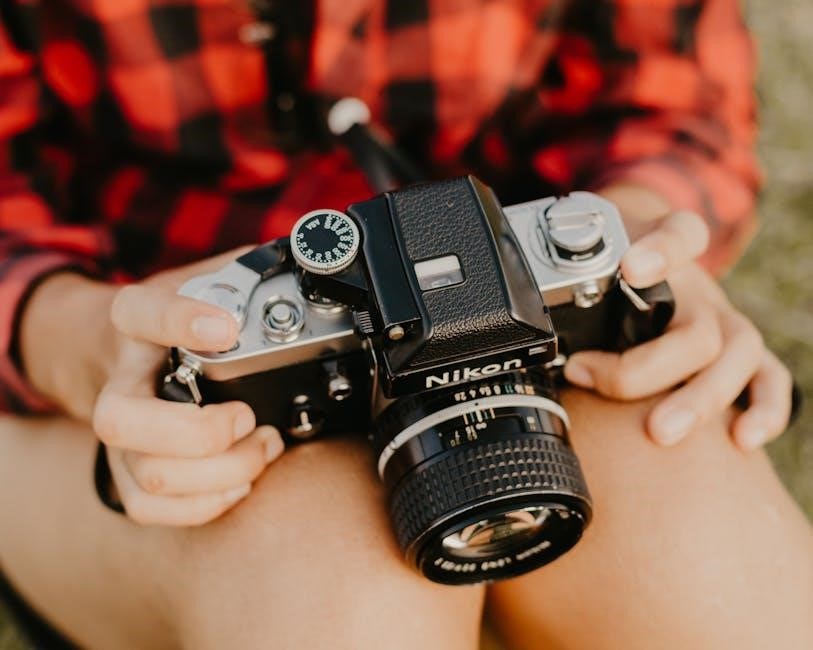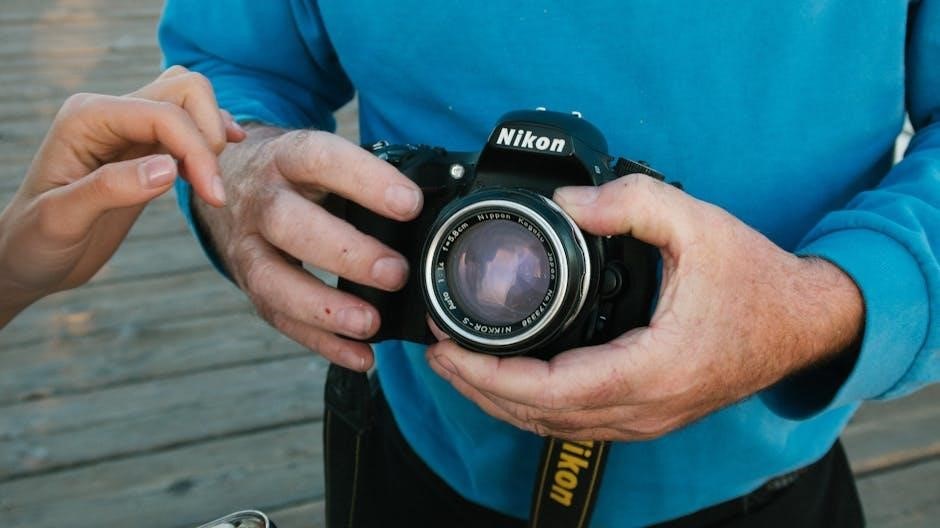nikon d500 manual
The Nikon D500 manual is the ultimate guide to unlocking your camera’s potential. Covering key features, settings, and troubleshooting, it ensures mastering the D500’s advanced capabilities. Download it from Nikon’s official site for comprehensive instructions on operation, customization, and maintenance, essential for both beginners and professionals to optimize their photography experience.
Overview of the Nikon D500
The Nikon D500 is a high-performance DSLR camera designed for professional photographers and enthusiasts. It features a 20.9 MP DX-format CMOS sensor paired with the EXPEED 5 image processing engine, delivering exceptional image quality and sensitivity up to ISO 51200. The camera boasts a 153-point Multi-CAM 20K autofocus system with 99 cross-type sensors, ensuring precise and rapid focus acquisition. It supports 4K UHD video recording at 30fps and offers advanced features like uncompressed HDMI output and in-camera time-lapse. Built-in Wi-Fi, NFC, and Bluetooth enable easy wireless connectivity and image transfer. The D500 combines durability, ergonomic design, and cutting-edge technology, making it a versatile tool for photography and videography.
Importance of Reading the Manual
Reading the Nikon D500 manual is essential for understanding its advanced features and optimizing performance. The manual provides detailed instructions on camera setup, operation, and customization, ensuring users make the most of its capabilities. It covers critical aspects like autofocus, metering, and video settings, helping photographers refine their techniques. The manual also includes troubleshooting guides and maintenance tips to prevent common issues. By thoroughly reviewing the manual, users can master the D500’s complex functions, enhance their photography skills, and troubleshoot problems effectively. Available in PDF format, the manual is accessible online, making it easy to reference anytime for improved workflow and creativity.
Downloading the Nikon D500 Manual
The Nikon D500 manual is readily available for download from the Nikon Download Center. Visit the official Nikon website, navigate to the support section, and search for the D500. The manual can be downloaded in PDF format, ensuring easy access on any device. It includes detailed instructions for camera setup, advanced features, and troubleshooting. Additionally, firmware updates and software like ViewNX-i can be downloaded alongside the manual. For convenience, Nikon also offers the Manual Viewer 2 app, allowing users to access the guide on mobile devices. Downloading the manual is essential for mastering the D500’s capabilities and ensuring optimal performance in various shooting conditions.

Camera Specifications and Technical Details
The Nikon D500 features a 20.9MP DX CMOS sensor, EXPEED 5 processor, and ISO range up to 51200. It offers 4K UHD video, 10fps continuous shooting, and a 153-point AF system.
Key Features of the Nikon D500
The Nikon D500 stands out with its 20.9MP DX-format CMOS sensor and EXPEED 5 image processor, delivering exceptional image quality and high sensitivity up to ISO 51200. It features the 153-point Multi-CAM 20K autofocus system with 99 cross-type sensors for precise subject tracking. The camera supports 4K UHD video recording at 30fps and offers advanced video features like uncompressed HDMI output. Additionally, it includes built-in Wi-Fi, NFC, and Bluetooth for seamless connectivity. The D500 also boasts a 3.2-inch touchscreen LCD, 10fps continuous shooting, and an expandable ISO range, making it a versatile tool for professionals and enthusiasts alike.
Sensor and Image Processing
The Nikon D500 features a 20.9MP DX-format CMOS sensor, paired with the powerful EXPEED 5 image processor, ensuring exceptional image quality and fast performance. This combination enables a wide ISO range of 100-51200, expandable to 1,640,000, making it ideal for low-light photography. The sensor’s design, along with the processor, minimizes noise and enhances color accuracy. The camera also incorporates the 3D Color Matrix Metering III system, utilizing a 180k-pixel RGB sensor for precise exposure control. These technologies work together to deliver sharp, detailed images with true-to-life colors, catering to both professionals and enthusiasts seeking high-quality results in various shooting conditions.
Autofocus and Metering Systems
The Nikon D500 boasts an advanced 153-point Multi-CAM 20K autofocus system, with 99 cross-type sensors for precise subject tracking. This system excels in dynamic and low-light conditions, ensuring sharp focus even on fast-moving subjects. The camera also features the Advanced Scene Recognition System with a 180k-pixel RGB sensor, enhancing metering accuracy and color reproduction. The 3D Color Matrix Metering III system provides balanced exposures by analyzing brightness, color, and distance information. These systems work seamlessly to deliver reliable autofocus performance and accurate exposure control, making the D500 a versatile tool for capturing high-quality images in diverse lighting scenarios and subject movements.
Video Capabilities
The Nikon D500 excels in video recording, offering stunning 4K UHD resolution at 3840×2160/30fps. It also supports 1080/60p Full HD video, enhanced by 3-axis electronic VR for smoother footage. The camera features uncompressed HDMI output, enabling high-quality external recording. Additionally, it includes Picture Controls and in-camera time-lapse capabilities, allowing for creative video production. With these advanced features, the D500 is ideal for professionals and enthusiasts seeking to capture high-resolution video with precise control over settings and output; Its video capabilities make it a versatile tool for documenting events, creating cinematic content, and more.
Connectivity Options
The Nikon D500 offers robust connectivity options, including built-in Wi-Fi, NFC, and Bluetooth. Wi-Fi enables wireless image transfer and remote camera control via smartphones. NFC provides quick device pairing for seamless file sharing. Bluetooth supports automatic photo transfers to smart devices, enhancing workflow efficiency. Additionally, the D500 features HDMI output for uncompressed video recording to external devices. These connectivity options integrate seamlessly with Nikon’s ecosystem, such as the Nikon Manual Viewer 2 app, allowing users to access manuals and firmware updates effortlessly. With these features, the D500 streamlines image sharing, remote operation, and external recording, catering to both professional and casual photographers.

Getting Started with the Nikon D500
Unbox, charge, and familiarize yourself with the Nikon D500. Mount lenses, insert memory cards, and power on. Read the manual to understand basic controls and settings.
Unboxing and Initial Setup
When unboxing the Nikon D500, you’ll find the camera body, rechargeable battery, battery charger, neck strap, body cap, and user manual. Ensure all items are included and undamaged. Start by charging the battery, which takes approximately 155 minutes for a full charge. Next, attach the neck strap and mount the provided lens or your preferred Nikon DX-format lens. Insert a memory card into the dual SD card slots, ensuring it’s compatible with the camera’s high-speed requirements. Power on the camera and follow the on-screen prompts to set the language, date, and time. Familiarize yourself with the camera’s ergonomic design and key controls before proceeding to advanced settings. Reading the manual at this stage will help you understand the camera’s basic operations and customization options. This initial setup is crucial for a smooth and enjoyable shooting experience with the Nikon D500.
Charging the Battery
To charge the Nikon D500’s battery, use the provided MH-25a charger. Connect the charger to a power source and insert the battery, ensuring it aligns with the charger’s contacts. The charging indicator will glow red during charging and turn green when complete. Full charging takes approximately 155 minutes. Avoid overcharging, as it may reduce battery life. For optimal performance, charge the battery when the camera’s battery level is low. Always use Nikon-approved chargers to prevent damage. Store the battery in a cool, dry place when not in use. Proper charging and maintenance ensure reliable power for your Nikon D500 during photography sessions.
Mounting Lenses and Accessories
To mount a lens on the Nikon D500, ensure the camera is turned off. Align the lens mount index with the camera’s mount index, then gently rotate the lens clockwise until it clicks. For accessories like the GP-1A GPS unit, attach them to the camera’s hot shoe or accessory shoe. Use only Nikon-approved accessories to maintain compatibility and functionality. Always handle lenses and accessories with care to avoid damage. Turn the camera off before mounting or removing any accessory. This ensures safe operation and prevents potential damage to the camera or accessory. Proper mounting is essential for optimal performance and image quality with the Nikon D500.
Basic Camera Controls
The Nikon D500 features intuitive controls designed for quick access to essential functions. The mode dial on top allows selection of shooting modes like Manual, Aperture Priority, and Auto. The release mode dial enables burst shooting or quiet operation. The multi-selector navigates menu options and selects autofocus points. The live view switch activates video or still image preview on the LCD. The exposure compensation button adjusts brightness, while the ISO button controls sensitivity. These controls provide efficient operation, allowing photographers to focus on composition and creativity. Proper use of these basic controls ensures optimal performance and image quality with the Nikon D500.

Advanced Camera Functions
The Nikon D500 offers advanced features like custom settings, autofocus fine-tuning, and detailed metering controls. These functions enable precise adjustments for professional-level photography, enhancing creativity and accuracy.
Custom Settings and Configurations
The Nikon D500 manual details extensive custom settings, allowing photographers to tailor the camera to their preferences. Users can configure shooting modes, autofocus behaviors, and metering options. The camera supports custom Picture Controls, enabling precise color and tone adjustments. Additionally, custom menus can be created for quick access to frequently used settings. These configurations enhance workflow efficiency and ensure consistent results. The manual guides users through setting up wireless connections, such as Wi-Fi and Bluetooth, for seamless image transfer and remote control. It also explains how to customize buttons and controls for personalized shooting experiences, making the D500 highly adaptable to individual needs.
Using the Autofocus System
The Nikon D500 manual provides detailed guidance on utilizing its advanced autofocus system. The camera features a 153-point Multi-CAM 20K AF system, with 99 cross-type sensors for precise subject tracking. Users can select from various AF modes, including Single AF, Continuous AF, and Group-Area AF, to suit different shooting scenarios. Custom AF-C modes allow photographers to fine-tune autofocus behavior for specific subjects. The manual explains how to configure AF settings, such as adjusting AF sensitivity and tracking lock-on, to optimize performance. Additionally, it covers techniques for using focus points effectively and customizing autofocus controls for enhanced shooting efficiency. Mastering these settings ensures sharper images and improved focus accuracy.
Understanding Metering and Exposure
The Nikon D500 manual explains the camera’s advanced metering and exposure systems. It features a 180,000-pixel RGB sensor for accurate light metering, supporting modes like Matrix, Center-weighted, and Spot metering. The manual details how to adjust exposure compensation and bracketing for precise control. Users can fine-tune settings to handle challenging lighting conditions, such as high contrast or backlit scenes. Custom exposure profiles can be saved for consistent results. The D500 also supports ISO sensitivity up to 51200, expandable to 1,640,000, ensuring excellent low-light performance. Understanding these features helps photographers achieve perfectly balanced exposures and optimize image quality in various shooting environments.
White Balance and Color Settings
The Nikon D500 manual provides detailed guidance on white balance and color settings to ensure accurate color reproduction. Users can choose from various presets, including Auto, Daylight, Tungsten, and more, or set a custom white balance for precise control. The camera also offers advanced color management through its Picture Controls, allowing adjustments to saturation, contrast, and sharpness. Additionally, the D500 supports manual color temperature settings for fine-tuning. The EXPEED 5 image processor enhances color accuracy and detail, while the ability to save custom profiles ensures consistent results. These features empower photographers to tailor their images to specific creative visions, whether in natural light or controlled environments;

Video and Time-Lapse Features
The Nikon D500 offers 4K UHD video recording, in-camera time-lapse, and HDMI output for professional-grade video capture, enhanced by the EXPEED 5 processor.
Recording 4K UHD Video
The Nikon D500 excels in recording 4K UHD video at 3840×2160/30fps. It supports professional features like uncompressed HDMI output and Picture Controls, allowing precise color grading and cinematic quality. The camera also includes in-camera 4K time-lapse functionality, enabling interval shooting for stunning time-lapse videos. With its EXPEED 5 image processor, the D500 ensures high-resolution video capture with minimal noise, even in low-light conditions. Additionally, the 3-axis electronic VR stabilizes footage during handheld recording, enhancing overall video production capabilities for both enthusiasts and professionals. The manual provides detailed instructions on optimizing these video settings for superior results.
Creating Time-Lapse Videos
The Nikon D500 allows you to create stunning time-lapse videos directly in-camera. Using the Interval Timer Shooting function, you can capture sequences of images at set intervals, which are then combined into a video. The manual provides detailed steps for setting up time-lapse photography, including selecting intervals, formatting memory cards, and enabling the feature. The D500 also supports 4K UHD time-lapse, offering high-resolution results. This feature is ideal for capturing dynamic scenes like sunsets, stars, or cityscapes. By following the manual’s instructions, you can achieve smooth transitions and professional-quality time-lapse videos with minimal post-production effort. The camera’s EXPEED 5 processor ensures optimal image quality throughout the process.
Using HDMI Output
The Nikon D500 offers uncompressed HDMI output, enabling high-quality video recording to external devices. The manual guides you through enabling this feature, selecting output resolution, and choosing frame rates. You can output 4K UHD video at 30p or Full HD at 60p, making it ideal for professional setups. The D500 also supports clean HDMI output, removing on-screen displays for a clearer signal. Additionally, you can customize settings like audio levels and focus peaking for enhanced control. This feature is perfect for filmmakers and videographers looking to capture superior video quality externally while maintaining camera operation convenience. The manual ensures seamless setup for optimal HDMI output performance.

Wireless Connectivity and Transfer
The Nikon D500 supports Wi-Fi and Bluetooth for seamless wireless connectivity. The manual details how to set up these connections, enabling easy image transfer to smart devices and remote control functionality.
Wi-Fi and NFC Setup
The Nikon D500 manual provides detailed instructions for setting up Wi-Fi and NFC connectivity. Users can wirelessly transfer images to smart devices or use remote shooting. Enable Wi-Fi in the camera’s menu, connect to your device, and use Nikon’s SnapBridge app for seamless transfer. NFC simplifies pairing with compatible Android devices. The manual guides you through network settings, device pairing, and troubleshooting common connection issues. This feature enhances workflow efficiency and allows for instant sharing of your photos. Follow the step-by-step instructions in the manual to ensure a smooth setup and optimize your wireless connectivity experience.
Bluetooth Connectivity
The Nikon D500 manual explains how to utilize Bluetooth connectivity for seamless image transfer and remote control. Enable Bluetooth in the camera’s menu to establish a low-power connection with compatible smart devices. The camera supports Bluetooth 4.1, ensuring stable and energy-efficient communication. Pair the D500 with your device using Nikon’s SnapBridge app, which allows automatic transfer of images and remote shooting capabilities. The manual provides step-by-step instructions for pairing, managing connections, and troubleshooting common issues. Bluetooth connectivity enhances workflow efficiency and enables convenient sharing of your photos. Follow the guide to set up and optimize Bluetooth for a smooth wireless experience with your Nikon D500.
Transferring Images to Smart Devices
The Nikon D500 manual details how to transfer images to smart devices using Wi-Fi and Nikon’s SnapBridge app. Enable Wi-Fi in the camera menu, then select images to transfer. The app allows automatic upload of photos marked as “Send to smart device.” This feature streamlines sharing and backup. For remote shooting, use the app to control the camera. Ensure both devices are connected to the same network for seamless transfer. The manual provides step-by-step guidance for setup and troubleshooting. This feature enhances workflow and accessibility, making it easy to share your photos instantly. Follow the guide to master wireless image transfer with your Nikon D500.

Maintenance and Troubleshooting
Regularly clean the camera and lens to maintain image quality. Update firmware for optimal performance. Address common issues like error codes or connectivity problems using troubleshooting guides for reliable operation.
Cleaning the Camera and Lens
Regular cleaning is essential for maintaining the Nikon D500’s performance. Use a soft, dry brush to remove dust from the camera body and lens. For more thorough cleaning, gently wipe the lens with a microfiber cloth, avoiding circular motions that may scratch the surface. Never use chemical products or abrasive materials, as they can damage the lens coating. For stubborn smudges, dampen the cloth slightly with distilled water, but ensure it is dry before wiping. Additionally, clean the camera’s image sensor periodically using a hand blower or Nikon-approved cleaning tools. Always handle the camera and lens with care to prevent damage and maintain optimal image quality.
Updating Firmware
Updating the Nikon D500’s firmware ensures optimal performance and resolves any software-related issues. Visit the Nikon Download Center using a computer with the latest Nikon software installed. Download the firmware update compatible with your camera model and carefully follow the on-screen instructions. Connect the D500 to the computer via USB, ensuring the battery is fully charged to avoid interruptions. Once the update begins, do not disconnect the camera or turn it off. After completion, verify the firmware version in the camera menu to confirm success. Regular firmware updates enhance functionality, improve compatibility, and fix bugs, ensuring your D500 operates at its best;
Common Issues and Solutions
Common issues with the Nikon D500 include error messages, camera freezes, or Wi-Fi connectivity problems. For error messages, restart the camera or update the firmware. If the camera freezes, remove the battery and reinsert it. Wi-Fi issues can be resolved by resetting the camera’s network settings or updating the firmware. Battery drain can be addressed by disabling Bluetooth and Wi-Fi when not in use. For lens compatibility problems, ensure using Nikon-approved lenses. If issues persist, refer to the manual or contact Nikon support for assistance. Regular maintenance and firmware updates help prevent and resolve many common problems, ensuring optimal camera performance.
The Nikon D500 manual provides essential guidance for mastering its features, troubleshooting, and maintenance. It empowers photographers to optimize performance and explore creative possibilities, fostering continuous learning and growth.
Final Thoughts on the Nikon D500
The Nikon D500 is a powerful DSLR designed for professionals and enthusiasts, offering exceptional image quality, speed, and versatility. With its 20.9 MP sensor, EXPEED 5 processor, and advanced autofocus, it excels in diverse shooting conditions. Its 4K video capabilities and robust build make it ideal for both stills and video. The camera’s wireless connectivity and intuitive controls enhance workflow efficiency. The Nikon D500 manual is indispensable for unlocking its full potential, providing detailed guidance on customization, troubleshooting, and maintenance. Whether for wildlife, sports, or studio photography, the D500 delivers outstanding performance, making it a reliable choice for creative professionals.
Continued Learning and Resources

Mastering the Nikon D500 requires ongoing learning and exploration of its advanced features. Nikon provides extensive resources, including the Nikon Manual Viewer 2 app, which offers digital versions of the manual for easy access. Additionally, Nikon’s official website and support pages offer firmware updates, software downloads, and detailed technical guides. Online forums and communities dedicated to Nikon users are invaluable for sharing tips, troubleshooting, and learning from experienced photographers. For deeper understanding, consider enrolling in photography courses or workshops that focus on DSLR cameras like the D500. Continuous practice and experimentation with the camera’s settings will further enhance your skills and creativity;